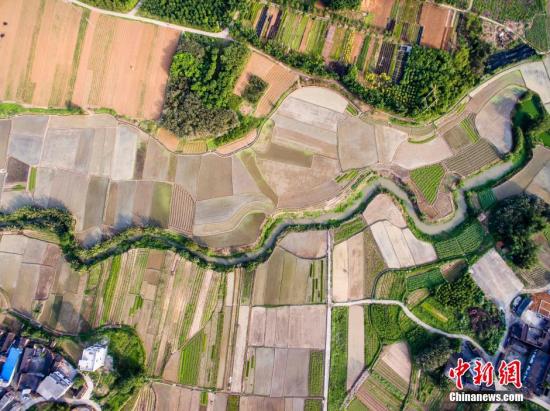Chinanews.com, January 13th. During the 14th Five-Year Plan period, how to ensure the safety of the supply of important agricultural products such as grain, cotton, oil, sugar, and meat?
At a press conference held by the State Council Information Office on the 13th, Zeng Yande, director of the Development Planning Department of the Ministry of Agriculture and Rural Affairs, said that ensuring the effective supply of important agricultural products is the key task of the agricultural and rural departments and the primary task of agricultural and rural modernization.
Among the key tasks include strengthening the protection and quality improvement of arable land, protecting arable land like giant pandas, and keeping the red line of 1.8 billion mu of arable land.
Data map: Aerial photography of the cultivated land in Shatang Town, Liubei District, Liuzhou City, Guangxi.
Photo by Huang Weiming
"In recent years, the economy has developed, living standards have improved, and the demand for agricultural products by urban and rural residents has increased, showing a characteristic of individuality and diversification. To adapt to this new change, agricultural production must ensure both quantity and diversity. It is even more important to ensure quality." Zeng Yande said that at present and in the future, we should focus on the following three aspects:
First, we must strengthen production capacity construction to guarantee the quantity.
It is to thoroughly implement the strategy of storing grain on the ground and storing grain on technology, consolidate and improve the comprehensive agricultural production capacity, and lay a solid foundation for food security.
Focus on two aspects. One is to strengthen the protection and quality improvement of cultivated land. It is to implement the strictest cultivated land protection system, protect cultivated land like giant pandas, and keep the red line of 1.8 billion mu of cultivated land.
At the same time, it is necessary to curb the "non-agriculturalization" of arable land, prevent "non-grainization", improve the basic conditions of farmland facilities, and accelerate the construction of high-standard farmland with high yield, stable yield, drought and flood.
The other is to improve scientific and technological support capabilities. An important task is to fight the seed industry's turnaround, focus on the core seed source "stuck neck" technology, independently cultivate a batch of breakthrough new varieties, and accelerate technological integration innovation. Promote the integration of agricultural machinery and agronomy, and cooperate with fine varieties and methods to give agriculture the wings of science and technology.
Second, we must optimize the production structure to ensure diversity.
It is necessary to strengthen planning and guidance, implement the regional layout and production supply plan of important agricultural products, build functional areas for grain production, protection areas for important agricultural products, and advantageous areas for characteristic agricultural products, optimize the variety structure, and focus on increasing high-oil, high-protein soybeans and forage corn We must also coordinate the production of important agricultural and sideline products such as grain, oil, sugar, meat, eggs, milk, fruit, vegetable and fish, expand oilseed production, accelerate the development of meat, beef and sheep, and continue to promote the revitalization of the dairy industry. Measures to meet the diverse needs of consumers.
Third, we must promote "three products and one standard" to ensure quality. We must persist in promoting agriculture through quality, green agriculture, and brand-strengthening agriculture, and increase the supply of high-quality green products. The focus is on the two "three products and one standard". The first is to vigorously develop green, organic, and geographically-indicated agricultural products in terms of products, and promote food The certificate of conformity for agricultural products; the other is to promote variety cultivation, quality improvement, brand building and standardized production in terms of production methods to enhance the quality, efficiency and competitiveness of agricultural products.

